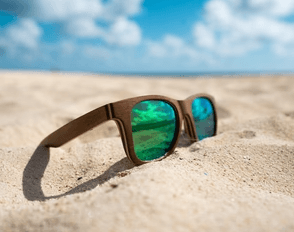The Science Behind Polarized Sunglasses


Polarized sunglasses are made to block out light wavelengths that vibrate horizontally, which reduces glare. They’re a go-to accessory for beachgoers, boaters, and drivers who spend much time outdoors in bright conditions.
Contents [show]
Light waves
Sunlight scatters as it hits varying points on uneven surfaces, but it becomes polarized when it strikes flat surfaces like water or snow. Polarized sunglasses cut this distracting glare to help you see the world with clearer vision.
Polarized lenses are ideal for activities requiring extended periods outdoors because the eye strain brought on by glare can cause weariness and headaches. They can also enhance contrast and definition, allowing your eyes to absorb more of the landscape without becoming overworked.
To determine if your sunglasses are polarized, hold them to another polarized surface (like a second pair of cheap sunglasses from the drugstore or an LCD screen). They’re probably polarized if they appear dark or nearly black compared to the other lens.
Look through them at a reflective object or surface and rotate the glasses 90 degrees. If the image on the screen brightens or darkens, your lenses are polarized, and you’ll enjoy the benefits of this unique feature. Polarized lenses are great for skiing, fishing, and other outdoor sports, where glare can be especially troublesome. Many polarized sunglasses also offer UV protection, which helps protect against harmful sun rays that can cause skin burns and cataracts. Ask your eye care specialist for advice on the best-polarized sunglasses that offer the optimum balance of comfort and functionality.
Reflection
When sunlight strikes flat surfaces, like water or asphalt, it tends to be reflected in a uniform direction. It creates a distracting, often dangerous intensity of light called glare that can make it difficult to see clearly. Polarized sunglasses have a filter that cuts out this intense, horizontally polarized reflected light. It allows vertical rays through but blocks glare to help you stay safe and see the world more comfortably and clearly.
Sunglasses with a polarized lens are coated in a particular chemical that reorganizes the long molecules of the lens to reduce reflection. This process can be applied to the surface of the lens (for less expensive lenses) or sandwiched between layers of the lens material for more expensive sunglasses.
Hold sunglasses to a polarizing screen such as a computer monitor or LCD TV to test whether sunglasses are polarized. If the screen darkens, the sunglasses are polarized and will provide UV protection. However, be aware that polarized sunglasses may make snow and other reflective surfaces appear darker than they would without them. It can be an issue if you’re skiing or snowboarding, where patches of black ice could hide and cause you to slip. For guidance on selecting the finest pair of polarized sunglasses, speak with an eye care specialist.
Transparency
Polarized lenses contain a chemical filter like vertical slats in a fence or tightly packed bars on a window. This filter blocks horizontal light or glare when sunlight bounces off water, roads, and snow. However, it allows vertical light to pass through the sunglasses. It allows you to see better by reducing distracting glare that could make it difficult or impossible to see your surroundings.
This type of glare is not only annoying, but it can be dangerous. For example, glare can interfere with your driving ability and cause you to miss important information about your surroundings, leading to accidents. That’s why athletes and outdoor enthusiasts often use polarized sunglasses.
If you don’t know if your sunglasses are polarized, you can check them by holding one lens up to another at a 90-degree angle. If the lenses turn nearly black or darken, they are polarized. Look at an LCD screen through the glasses to confirm their effectiveness. If the screen looks very hard to read, they are polarized. Your VSP network eye care professional can help you find a pair of polarized sunglasses that fit your needs. Ask about combining them with features such as bifocal or progressive lenses and anti-reflective coatings for maximum performance.
Polarization
Polarized sunglasses have a special filter coating to reduce the intensity of reflected sunlight. This filter works like the vertical slats on a window blind or tightly packed bars on a window, only allowing light to pass through when it’s long and horizontal. It effectively blocks the horizontal reflections that create glare off flat surfaces, such as water or snow.
When unpolarized light reflects off a smooth surface, it vibrates in all directions, producing an annoying glare. However, physicist Etienne-Louis Malus discovered in 1808 that the oscillation of unpolarized light waves can be aligned in a specific direction when it bounces off a specular surface, such as a lake or road. Polarized lenses are designed to take advantage of this phenomenon, reducing the glare that would otherwise distract you from enjoying your time outdoors.
Polarized sunglasses enhance contrast, make colors seem more bright, and decrease glare. They are beneficial for anyone who spends much time outdoors or on the water and for people with light sensitivity, as they can reduce eye strain and headaches. However, it’s important to note that polarized lenses don’t protect against UV rays. To be fully protected, you still need to apply sunscreen and wear UV-protective sunglasses.





